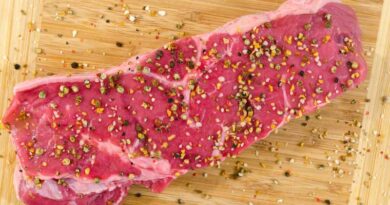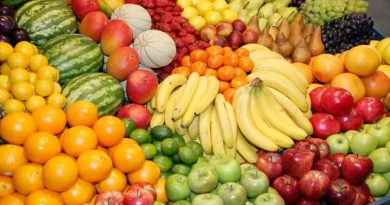Five-a-day – is it enough?!
This is a blog about an article in The Independent, in which I was quoted. You may not be able to read the article on line for very long because The Independent has really annoying moving adverts down both sides of the page. However, you just need to whiz through it to get a feel for the debate – the article is what you’d expect from The Independent – a middle of the road drive through some big issues, but let’s not really go anywhere.
I discovered during the writing of my book “The Obesity Epidemic” that five-a-day was invented by a bunch (ha ha) of fruit & veg companies at a meeting with the American National Cancer Institute in 1991 (not 1998, as the article says). The American National Cancer Institute has since trademarked the term and the fruit & veg manufacturers, logistics and packaging companies hit the jackpot with this marketing slogan, as it is now ‘out there’ in c. 25 countries across 3 continents.
It was good to see Tim Lang, Professor of Food Policy at City University London confirming the lack of evidence in the article: “It was a political fudge,” Lang says, “there was very little evidence basis for it. They just chose a figure that was aspirational but not so high as to be perceived as impossible to reach.” Lang, it seems however, would be happy if the bar were set at 9-a-day – as it already is in Australia & Greece. However, as happens with non-evidenced bases messages that spread, Denmark advises 6-a-day, Ireland 4-a-day and I detail the whole range of variations on p204 of my book.
This article is not about the debate as to whether or not there was evidence before the creation of 5-a-day that 5-a-day would do anything to help cancer because there can be no debate. There was no evidence at the time that eating 5 portions of fruit & veg a day would help cancer – which was the only medical condition involved at the outset. There can be little debate that evidence has been found since – the EPIC (European Prospective Investigation into Cancer) concluded in April 2010 as follows. (Please note that this study was set up in 1991 – surely coincidence ;-) ):
April 2010 – report from the EPIC study:
In April 2010 a study was published in the Journal of the National Cancer Institute written by Paolo Boffetta, as the lead of a large group of European researchers. The study sought to quantify if cancer risk were inversely associated with intake of fruit and vegetables. The article analysed data from the EPIC study, involving 142,605 men and 335,873 women for the period 1992-2000. This review of almost half a million people found that eating five portions of fruit and vegetables a day had little effect on cancer risk and the very small difference observed could be explained by other factors. The study also grouped participants into five categories from the lowest intake of fruits and vegetables (0 to 226 grams a day) to the highest intake (more than 647 grams a day). Significantly, the cancer risk did not vary between the five groups. The overall conclusion of the study was that:
“A very small inverse association between intake of total fruits and vegetables and cancer risk was observed in this study. Given the small magnitude of the observed associations, caution should be applied in their interpretation.”
The British arm of the EPIC study reported the same later on in 2010:
November/December 2010 – report from the EPIC study:
A report published in the British Journal of Cancer 30 November 2010, written by Professor Tim Key – UK leader for the EPIC study, concluded:
“The possibility that fruit and vegetables may help to reduce the risk of cancer has been studied for over 30 years, but no protective effects have been firmly established.”
This post is about the report which stimulated interest in The Independent article:
January 2011 – report from heart people at Oxford using the EPIC data:
The article refers to a report published in the European Heart Journal on 18 January 2011. It was covered in the press at the time, but The Independent picked up on it last week (16 March 2011).
Let’s just be clear at the outset what’s going on here. A huge, and no doubt hugely expensive, study has been done across Europe, involving half a million people, trying to establish even an association (not causation) between cancer and fruit & veg intake and the study has not been able to conclude this (and that alone says something, as most statistics can be manipulated, as we will see just below).
So, people studying heart disease have used the cancer study data to see if they can come up with an association (never, never leap to causation) between fruit & veg intake and heart disease. To be fair – the conclusion in the “abstract” (summary) of the report is as follows:
“Results from this large observational study suggest that a higher intake of fruits and vegetables is associated with a reduced risk of IHD mortality. Whether this association is causal and, if so, the biological mechanism(s) by which fruits and vegetables operate to lower IHD risks remains unclear.”
(NB ischaemic (ischaemia = reduced blood supply) heart disease = heart disease excluding strokes)
So, the researchers didn’t make the causation mistake in their summary. However, in the abstract, we have the following details about methods & results:
– There were 1,636 deaths from IHD from a study of 313,074 men and women from 8 European countries. That gives a death rate of 0.52% from IHD in nearly 10 years (the average years of follow-up was 8.4).
– The journal says: “Participants consuming at least eight portions (80 g each) of fruits and vegetables a day had a 22% lower risk of fatal IHD [relative risk (RR) = 0.78, 95% confidence interval (CI): 0.65–0.95] compared with those consuming fewer than three portions a day. After calibration of fruit and vegetable intake to account for differences in dietary assessment between the participating centres, a one portion (80 g) increment in fruit and vegetable intake was associated with a 4% lower risk of fatal IHD (RR = 0.96, 95% CI: 0.92–1.00, P for trend = 0.033).”
So, in the method & results details, they do make the leap from association to risk – this is done all the time in studies and is bad science. They have effectively observed that there seems to be an association between people being in the bath and singing. They can no more say that being in the bath increases one’s risk of singing than they can say singing increases one’s risk of taking a bath. Or that either increases the risk of anything.
Note the second sentence – not the one that gave the 22% lower risk headline in The Independent article – that’s the memorable thing that sticks in the minds of the public and makes them rush out to add fruit & veg to their likely expanding waist lines. “After calibration of fruit and vegetable intake to account for differences in dietary assessment between the participating centres”… i.e. after adjusting for the fact that different centres were assessing intake differently, the difference is tiny (0.96 vs 0.92) – they surely cannot claim this as significant even for association, let alone causation.
Lies, Damned lies & Statistics
What newspapers want is the screaming headline “30,000 lives will be saved” (No lives will ever be saved, by the way – we’re all going to die. We may be able to delay likely time of death by a couple of months (see Dr M Kendrick’s brilliant analysis of the maximum possible impact of statins in “The Great Cholesterol Con“), but you’re going to die) or “22% lower risk of X”. This is wrong, misleading and, quite frankly, dishonest.
Forgive me for not paying the $40 to be able to view the full article for one day. I don’t know if the article would detail the categories of fruit & veg that the deaths were divided between and the numbers of people in each category, but I could guess “fewer than 3 portions”; “3-5”; “5-7” and more than 8 and then let’s say it looked something like the following…
If you start from the assumption that people in each of 4 fruit & veg consumption groups were distributed evenly in terms of number of people and deaths, then 78,269 people would be in each group (total 313,074) and 409 deaths ‘should’ have occurred in each group (total 1,636) (notwithstanding that there are too numerous to cover reasons as to why deaths would not be distributed evenly – nothing to do with fruit & veg). For the deaths in the 8+ group to be 22% lower than the deaths in the fewer than 3 group, keeping the deaths in the 3-5 and 5-7 groups at 409, deaths in the 8+ group would be 369 and deaths in the fewer than 3 group 449. Hence 0.47% of the higher intake group would have died during the period reviewed and 0.57% of the lower intake group – not such an impactful headline when you state the facts.
But here’s the killer point – this is merely an observation. What lifestyle do you think people lead who are consuming more than 8 portions of fruit and veg per day? Do you think they put down their cigarettes, or recreational drugs, to free up a hand to eat an apple? Do you think they are sat on their fat and lazy backsides watching TV munching crudités? Or do you think people consuming 8 portions or more of fruit & veg a day are generally ‘healthy’ people – shunning processed food in favour of fresh, naturally active, not smoking, managing stress levels and so on. So this study might have observed that overall healthy people have fractionally lower heart disease than people who have less healthy lifestyles.
Hardly hold the front page now!
For a final couple of points:
1) We MUST start distinguishing between fruit and veg. Veg can be quite nutritious – especially the dark green leafy vegetables and especially when cooked in/eaten with butter to deliver the fat soluble nutrients within. Fruit is so different – high in fructose (and glucose) – which is the perfect fattening combination in the world of obesity (indeed fructose along has been called the fattening carbohydrate for some time – it just takes public health advisors a dangerously long time to catch up.) Low starch vegetables and salads definitely have a place in a healthy, enjoyable and varied diet. But, as Gary Taubes says, “If you are overweight, fruit is not your friend”, and that’s the world in which I work – obesity.
2) There are so many other far more important factors which could and should be looked at and yet no one is going to get funding for a study looking at the damage being done to human beings by the staggering British and American consumption of sugar and white flour. The Sugar Bureau and Flour Advisory bureau wouldn’t like it and our eatbadly plate (the UK role model of health eating) is, inexplicably, trying to drive precisely this food consumption – a la “base your meals on starchy foods”. Whatever you do, don’t eat meat, eggs and butter, which are stacked with vitamins and minerals, essential fats and essential proteins (there is no such thing as an essential carbohydrate – interesting).
What people are NOT eating is likely more important than what they are. People who DON’T eat sugar, flour and processed food are vastly more likely to be healthy than people who consume the 400 cals of sugar and 730 cals of flour that the average Brit (and American) eats per day. The Seven Countries Study made exactly this error – it concluded that America ate a lot of fat and Japan ate very little and this was why heart deaths were so different. Japan also ate no processed food whatsoever at the time (1956-1970) and the American coca-cola, burger, hot dog culture was well under way in the USA. It was not any real fat in real food that had anything to do with heart disease – it was any processed food (carbs or fats) that the Americans were eating.
If the idiot powers that be try to get people to eat 8-a-day, instead of the already fattening and unjustifiable 5-a-day, obesity will rise even faster and more certainly than it is now. People are trying to eat 5-a-day in addition to everything else they are eating. People are also majoring on fruit, rather than veg (because it’s sweeter) and consuming fruit juice, dried fruit and other fattening things. Childhood obesity is being fuelled by trying to get 5 portions of fruit juice, dried fruit, sweetcorn on pizza etc into already fat little Johnny.
Or – as The Independent ‘helpfully’ illustrates how we can get our 8-a-day – sweet potatoes (actually higher in carb than normal potatoes), dried fruit, salty soup, sugary baked beans, banana milk shake – and you wonder why we have an obesity epidemic!




Hi Zoe
I have a copy of the paper by Crowe et al and your conclusions based on the abstract are pretty accurate. I’d like to add that the abstract doesn’t mention that the association between fruit and veg intake and IHD is NOT significant for men – even though more men died – must have forgotten to include that in the abstract. Also there is a small but significant reduction in risk associated with each portion increase but as the authors admit, the only randomised trial on this (the women’s health initiative) did not show a significient impact for each increase in portion increase. In other words, the significant association in the Crowe study was shot to flames by a real RCT. So much for epidemiology!
Can send you a PDF of paper if you want.
Rod
You are right about the 5 a day, but not so sure about carbs per se being bad, as in potato or sweet potato. The latter two are considered safe starches, as have written by the authors, Drs. Jaminet of The Perfect Health Diet. Even white rice is considered safe. It’s carbs that are in the form of wheat such as bread, pasta and the likes, and of course sugar and all other processed food that are bab and toxic. Potatoes are whole foods and they are safer and more nutritious than pasta or other wheat based products. Not all carbs are created equal. I think carbs have been given a bad rep due to the conventional low carb diets ala Atkins, Paleo and Primal.
Thank you. I still enjoy reading your blog!